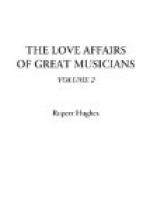Even if the princess had not been beautiful, La Mara thinks she would have overwhelmed Liszt with “her wonderful eloquence and her unbelievable intellectuality.” It was a case of congeniality at first sight. There were many meetings. The concert affected the princess deeply (when she died she bequeathed that programme to her daughter). The day after the concert, she heard a Pater Noster of his sung in the church. Liszt talked of his plans for compositions. He said he wished to express in music his impressions of Dante’s “Divina Commedia,” with a diorama of scenic effects. To fit out the diorama, it needed about $15,000.
The princess, carried away with the idea, offered him the money from her own purse. The diorama was never built, but it required a great many conferences, and it seemed appropriate that Liszt should visit her at her estate, Woronince. He arrived on the tenth birthday of her little daughter, Marie. This was in February, the same month of their first meeting. But he could not stay many days, as his concert tour took him to Constantinople and elsewhere. But in the summer and again in the autumn they met, and they celebrated together his birthday and her saint’s day.
She there and then resolved to give up her life to him, and to marry him as soon as might be. She believed in the autocracy of genius, and felt that she recognised her mission in the world—to follow and aid this maker of music. Separation from her husband was tame, but this was a horrifying breach of conventionality, such another as the Comtesse d’Agoult had smitten Paris with thirteen years before. But none the less, in April, 1848, she took her daughter and left Russia, after she had provided herself, by the sale of a portion of her dowry, with a sum, as La Mara says, of a million roubles—equal to about $750,000—a tidy little parcel for an eloping couple.
For her husband and mother-in-law she left letters—it would seem that there must have been little else to leave—explaining that she would never return. At the same time she instituted divorce proceedings, and announced that she was asking the Church to grant her freedom. Being a Catholic, it was necessary for her to persuade the Pope himself to permit her to wed Liszt. In the meanwhile, her husband went to the Czar and loudly bewailed the loss of his daughter and all his money. The old story—“My daughter! Oh, my ducats! Oh, my daughter! Oh, my Christian ducats! Justice! the law! My ducats and my daughter!”
The princess fled across the Russian border, just at the time of the Revolution of 1848. At the Austrian boundary Liszt’s faithful valet met her; in Ratibor she found Liszt’s friend, the Prince Lichnovski, who some months after fell a martyr to the revolution. He conducted her to Liszt. A few days later they visited the prince for two weeks at one of his castles. The troubles of the revolution and the barricaded streets drove them from the country to Weimar, where Liszt had been given the post of Kapellmeister.




